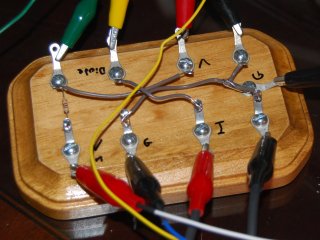

Having now acquired several crystal radios by purchase (two) or building my own (four), I begin to wonder how they stack up against each other and against other radios I read about and dream of on the net. It can be fairly common to hear radio performance described in qualitative terms, "high Q", "sharp tuning", "highly sensitive", etc. Without measured numbers to back them up, it is extremely difficult to judge the subjective notes of different radio users. It is inevitable I believe that in this hobby that one ends up getting together as much test equipment as possible, (read "affordable") in order to know more objectively about the radios one builds and/or uses. This page is the tale of my own effort to equip a small "laboratory" of sorts for just such purpose.
My first needs were related to my building projects and included meters for measuring capacitance and inductance. I have excellent-quality bench meters for other hobby projects including a Keithley 192 and 181 voltmeter with IEEE 488 computer interfaces. These are voltmeters only though, nothing else. My first purchase then was a capacitance/inductance meter. It worked great for capacitance, but the lowest range for inductance, 20mH unfortunately is useless. So, this meter was quickly followed by a stand-alone inductance meter ranging down to 200uH. I use these frequently when making or measuring coils, and measuring capacitors purchased on ebay, better to design a radio around a specific componant.
My next needs follow logically, what about the radios I build?, how do they do? For the non-electrical engineer, testing radios is a bit of a daunting task and this page is by no means intended to be a tutorial. I do give my experiences so that perhaps someone with the same idea may benefit and possibly avoid the mistakes I have certainly made. I describe my equipment and the protocols used in my testing, but I STRONGLY refer the reader to the following two pages for technical guidance and explanations, most of what I do came directly from here:
Dick Kleijer crystal-radio.eu http://www.crystal-radio.eu/enqmeting.htm
Gollum�s Crystal Receiver World http://home.snafu.de/wumpus/gollum/testing.htm article by C.A. Lauter
I heartily express my appreciation to our European friends for making available on the web these excellent technical tutorials for crystal radio testing.

Testing and understanding your set from the Antenna at the front, the tank in the middle and on to the Diode at the back and then the Radio complete, the whole shebang!
 ANTENNA TUNING UNIT.. Design notes and Models, Effect of earth resistivity..
ANTENNA TUNING UNIT.. Design notes and Models, Effect of earth resistivity..
 AMPLITUDE MODULATION.. Excel modeling of Modulation and DeModulation..
AMPLITUDE MODULATION.. Excel modeling of Modulation and DeModulation..
 COIL Q.. An Analytical Approach to the measurement of coil Q.
COIL Q.. An Analytical Approach to the measurement of coil Q.
 COIL Q Revisited.. Web research and personal measurements: Setting expectations for Q.
COIL Q Revisited.. Web research and personal measurements: Setting expectations for Q.
 Crystal Radio Capacitors.. A look at capacitor Q and its relation to ESR (Equivelant Series Resistance).
Crystal Radio Capacitors.. A look at capacitor Q and its relation to ESR (Equivelant Series Resistance).
 Diode I: Setup and Protocol.. Describes a useful protocol for determination of Diode Is, n, and Ro.
Diode I: Setup and Protocol.. Describes a useful protocol for determination of Diode Is, n, and Ro.
 Diode II: Test Data Measurements .. Reports the measurements made under the above protocols for a large variety of diodes
Diode II: Test Data Measurements .. Reports the measurements made under the above protocols for a large variety of diodes
 Diode III: Vacuum Diodes.. Measurements and discussion on vacuum diode utility in crystal radio.
Diode III: Vacuum Diodes.. Measurements and discussion on vacuum diode utility in crystal radio.
 Diode IV: Discussion and Results.. A discussion of diode I/V characteristics, Ro and matching, and sundry ravings.
Diode IV: Discussion and Results.. A discussion of diode I/V characteristics, Ro and matching, and sundry ravings.
 RESONANCE.. A look at some theory and resonance calculations for MW sets.
RESONANCE.. A look at some theory and resonance calculations for MW sets.
 MATCHING TRANSFORMER.. Getting maximum power transfer to the audio circuit.
MATCHING TRANSFORMER.. Getting maximum power transfer to the audio circuit.
 RADIO TEST.. Describes protocols and results of radio performance testing on my sets.
RADIO TEST.. Describes protocols and results of radio performance testing on my sets.
 BIG LITZ.. This is where I try to put everything together with a full analysis of my top set.
BIG LITZ.. This is where I try to put everything together with a full analysis of my top set.


